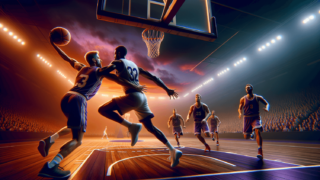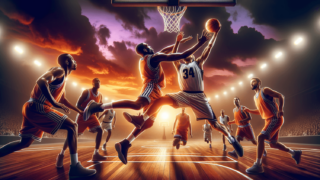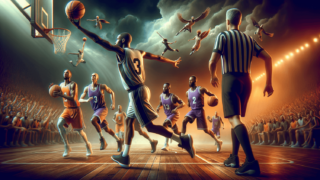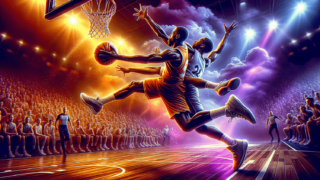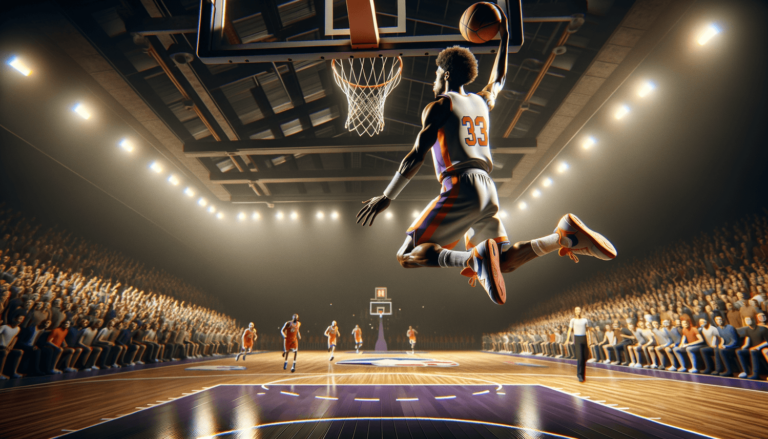
Technical Foul for Hanging on the Rim in Basketball
Written by: Basketball Universe
Last updated:

In the electrifying world of basketball, one can nonchalantly admire the high-flying, gravity-defying dunks players effortlessly pull off. While we often celebrate the rim-rocking dunk, there’s an intriguing aspect to it that fans might overlook—the technical foul for hanging on the rim. This rule often provokes a mixed bag of emotions among players and spectators alike. So, strap in as we dive into the nitty-gritty of this attention-grabbing regulation, exploring its intricacies, touching on scenarios where it applies, and delving into some of basketball’s most memorable moments involving this thrilling yet controversial subject.
Technical Foul for Hanging on the Rim in Basketball
A technical foul for hanging on the rim in basketball refers to the penalty given when a player grasps the rim for an extended period without a justifiable reason, such as avoiding injury. This rule intends to prevent unsportsmanlike behavior, maintain a safe playing environment, and ensure proper equipment usage. Generally, referees determine the foul based on factors like the length of time spent gripping the rim, the player’s intention, and whether the rim is pulled down during the process. When called, the opposing team is awarded one free throw attempt as a result of this technical foul.
Understanding the Basketball Rules: Technical Foul for Hanging on the Rim
Basketball is a fast-paced and enthralling game where split-second decisions make all the difference. Whether you’re a die-hard fan or a casual observer seeking to deepen your knowledge of the sport, understanding the technical foul for hanging on the rim is essential. Let’s take a closer look at the various elements surrounding this rule, providing a comprehensive guide to enhance your appreciation for the game.
Why Does the Rule Exist?
At first glance, it may seem odd that basketball has rules preventing players from hanging on the rim after a dunk. However, the rule was established primarily for safety reasons, in addition to promoting good sportsmanship and preserving the functionality of the equipment. Hanging on the rim can cause a player to lose balance and fall, endangering their safety and that of other players on the court. Moreover, persistent hanging on the rim may cause damage to the hoop, affecting the continuity and fluidity of the game.
Decoding the Rule
According to NBA rules and FIBA guidelines, a technical foul for hanging on the rim occurs when a player grasps the rim without erring on the side of caution. Referees examine several factors when enforcing this rule:
Time Spent on the Rim
The length of time a player hangs on the rim is crucial in determining whether a technical foul should be called. Briefly touching the rim after a dunk is typically allowed, but prolonged contact is subject to scrutiny.
Intent of the Player
Referees also consider the player’s intention when hanging on the rim. A player who grasps the rim to avoid potential injury—when falling in a crowded area, for instance—is less likely to be penalized than someone who does so to gain an unfair advantage or showboat.
Pulling Down on the Rim
Pulling down on the rim while hanging can result in a technical foul, as it poses a risk to the player’s safety and may damage the equipment. In some cases, referees may even consider it a flagrant foul if it poses a severe threat to the player or other individuals on the court.
Violation Consequences
When a referee calls a technical foul for hanging on the rim, the offending player’s team is penalized by awarding the opposing team one free throw attempt. Although this may not seem like a significant punishment, it provides the infringing player and team a reminder to adhere to the rules, ensuring a safer and more enjoyable experience for all involved.
Exceptions to the Rule
It’s essential to remember that not all cases of hanging on the rim warrant technical fouls. In some scenarios, referees allow players to grasp the rim without penalizing them:
Avoiding Injury
As stated earlier, players who hang on the rim to prevent injury are typically exempt from technical fouls. This can occur when attempting a dunk or a block in a congested area, where the player momentarily holds the rim to maintain balance and ensure a safe landing.
Rim Rebound
On rare occasions, players may inadvertently grasp the rim when jumping for a rebound. Referees will evaluate these cases on an individual basis and are unlikely to call a technical foul if the action was unintentional and didn’t provide an unfair advantage.
Famous Incidents Involving Technical Fouls for Hanging on the Rim
Over the years, there have been some high-profile incidents involving players receiving technical fouls for hanging on the rim, often resulting in intense reactions from both the players and the fans. However, these incidents serve as reminders of the importance of the rule in preserving the sport’s integrity and ensuring the safety of everyone involved. Let’s explore some unforgettable moments where this rule played a significant role:
Shaquille O’Neal Breaks the Backboard
In a 1993 game between the Orlando Magic and the New Jersey Nets, NBA legend Shaquille O’Neal famously shattered a backboard following a powerful dunk. Shaq’s immense force and the extended time he spent hanging on the rim resulted in the backboard’s glass material shattering, causing a rain of glass to shower onto the court. The incident led to the imposition of a technical foul and a lengthy delay to replace the broken backboard.
Vince Carter’s Olympic Alley-Oop
In the 2000 Sydney Olympics, Team USA’s Vince Carter famously hung on the rim after performing an incredible alley-oop dunk against France. Since Carter’s hang time didn’t impede gameplay or increase the risk of injury, the referees didn’t call a technical foul on this occasion. Nonetheless, the instance serves as a reminder of the thin line between an acceptable rim hang and a punishable offense.
Learning from the Pros
The game of basketball has evolved significantly over recent decades, with athletes like Michael Jordan, Shaquille O’Neal, and LeBron James showcasing remarkable feats of athleticism that push the limits of what was previously thought possible. As basketball continues to develop stylistically and athletically, understanding the nuances of the game’s rules, such as the technical foul for hanging on the rim, ensures the sport remains safe and enjoyable for all involved, from the recreational pickup game to the professional arena.
Final Thoughts
The technical foul for hanging on the rim is just one of many basketball rules that help preserve both player safety and the spirit of the game. Whether you’re a long-time aficionado, a new enthusiast, or a budding athlete, understanding the intricacies and objectives of the game’s regulations will help you appreciate the action on the court like never before. So the next time you witness an amazing dunk, remember the importance of having knowledge about these rules for the game, players, and fans we all love.
Strategies for Preventing Technical Fouls for Hanging on the Rim
While it can be easy to get caught in the heat of the moment, avoiding a technical foul for hanging on the rim is crucial for maintaining player safety and promoting good sportsmanship. Here are some practical tips and strategies for players to minimize the risk of receiving a technical foul related to rim hanging:
Develop Body Control
One of the best ways to prevent hanging on the rim is by improving body control and developing a strong sense of spatial awareness. This will enable players to land safely after dunks or blocks without the need to grasp the rim for stability. Incorporating exercises such as core strength training and plyometrics into your fitness regime can improve body control and help minimize the risk of inadvertently breaking the rules.
Understand the Game Situation
Being aware of the game situation can play a vital role in preventing technical fouls for hanging on the rim. Assessing the risk of injury or entanglement with other players can help you determine whether it’s necessary to grasp the rim briefly. If you’re unsure whether hanging on the rim is permissible in a specific situation, erring on the side of caution is always advisable.
Communicate with Referees
Establishing open communication with referees is essential for understanding their interpretations of basketball rules, including those related to hanging on the rim. While players should avoid questioning the referee’s decisions during a game, seeking clarification on any ambiguities in the rules outside the game will help you adapt your play accordingly and reduce the likelihood of technical fouls.
Enforcement in Different Basketball Leagues
In addition to the NBA and FIBA, countless basketball leagues worldwide enforce their rules and regulations, including those governing hanging on the rim. Let’s explore how some of these leagues address this particular technical foul:
College Basketball (NCAA)
In college basketball, the NCAA has regulations similar to those of the NBA and FIBA. They emphasize the importance of player safety and sportsmanship, and hanging on the rim is prohibited unless the player is avoiding injury or momentum carries them onto the rim. The consequences for receiving a technical foul in college basketball also generally include awarding one free throw attempt to the opposing team.
High School Basketball (NFHS)
In high school basketball, the National Federation of State High School Associations (NFHS) oversees the rules and regulations. They, too, stipulate that hanging on the rim is a technical foul unless the player does so to avoid injury. High school basketball’s enforcement and consequences of technical fouls for hanging on the rim are comparable to those in college and professional leagues.
Other Amateur and Recreational Leagues
Various amateur and recreational leagues worldwide follow the general principles behind the technical foul for hanging on the rim, with player safety and sportsmanship as top priorities. However, the specific rules and penalties associated with hanging on the rim can vary across leagues, so it’s crucial for players and coaches to familiarize themselves with the regulations of their specific organization.
Developing a Deeper Appreciation for Basketball
As you gain more knowledge and understanding of basketball rules, such as the technical foul for hanging on the rim, you’ll develop a deeper appreciation for the complexities, strategies, and subtleties of the game. This will not only make you a more knowledgeable fan but can also enhance your playing abilities by enabling you to adapt your game to align with established regulations. Remember, player safety and promoting good sportsmanship should always be at the forefront of every basketball enthusiast’s considerations, ensuring the game remains a thrilling and enjoyable spectacle for years to come.
Frequently Asked Questions about Technical Foul for Hanging on the Rim
When it comes to basketball’s technical foul for hanging on the rim, numerous questions may arise amongst fans, players, and coaches alike. To help navigate these inquiries, we’ve compiled a comprehensive FAQ section addressing some common concerns and curiosities.
1. Why is hanging on the rim considered a technical foul?
Hanging on the rim is considered a technical foul because it poses risks to player safety, and it may damage the equipment or be viewed as unsportsmanlike conduct. The rule aims to maintain a safe and fair playing environment for all participants.
2. How long can a player hang on the rim without being penalized?
There is no specific time limit for hanging on the rim. However, referees generally permit players to grasp the rim briefly after a dunk or a block. Prolonged contact with the rim is more likely to result in a technical foul.
3. Can a player hang on the rim to avoid injury?
Yes, a player is allowed to hang on the rim to avoid injury, such as when they are falling in a crowded area or when momentum carries them onto the rim. In these cases, a technical foul is typically not called.
4. Are there other situations when hanging on the rim is allowed?
Besides avoiding injury, referees may allow players to hang on the rim if it was a result of an unintentional action, like an inadvertent grasp during a rebound. Technical fouls are unlikely to be called in such cases if no unfair advantage was gained.
5. What are the consequences of receiving a technical foul for hanging on the rim?
When a player is called for a technical foul due to hanging on the rim, the opposing team is awarded one free throw attempt. This penalty serves as a reminder to follow the rules and promotes safety and sportsmanship in the game.
6. Is hanging on the rim the same in different basketball leagues?
While the primary principles regarding technical fouls for hanging on the rim tend to be similar across basketball leagues, specific rules and penalties may vary. Players and coaches should consult the rulebooks of their respective leagues to ensure proper understanding and compliance.
7. How can I avoid receiving a technical foul for hanging on the rim during a game?
Some practical tips to avoid receiving a technical foul for hanging on the rim include improving body control and spatial awareness, being mindful of game situations, and maintaining open communication with referees to clarify any ambiguities in the rules.
8. Can a referee call a flagrant foul for excessively hanging on the rim?
A referee may call a flagrant foul if a player’s actions, such as pulling down on the rim while hanging, pose a severe threat to the player’s or other individuals’ safety on the court. Such scenarios are considered especially dangerous and warrant stricter penalization.
9. Does the technical foul for hanging on the rim apply to both offensive and defensive players?
Yes, the technical foul for hanging on the rim applies to both offensive and defensive players, regardless of their role in the play. The key factor is the player’s action and the potential risks it poses to safety, sportsmanship, and equipment.
10. Have any famous incidents involving technical fouls for hanging on the rim occurred in basketball history?
Yes, there have been several famous incidents involving technical fouls for hanging on the rim, such as Shaquille O’Neal breaking the backboard in 1993, leading to a technical foul imposed upon him. Another instance includes Vince Carter’s Olympic alley-oop in 2000, where he hung on the rim but was not penalized due to the referees’ discretion.
Featured Posts
- No pillar pages found.
